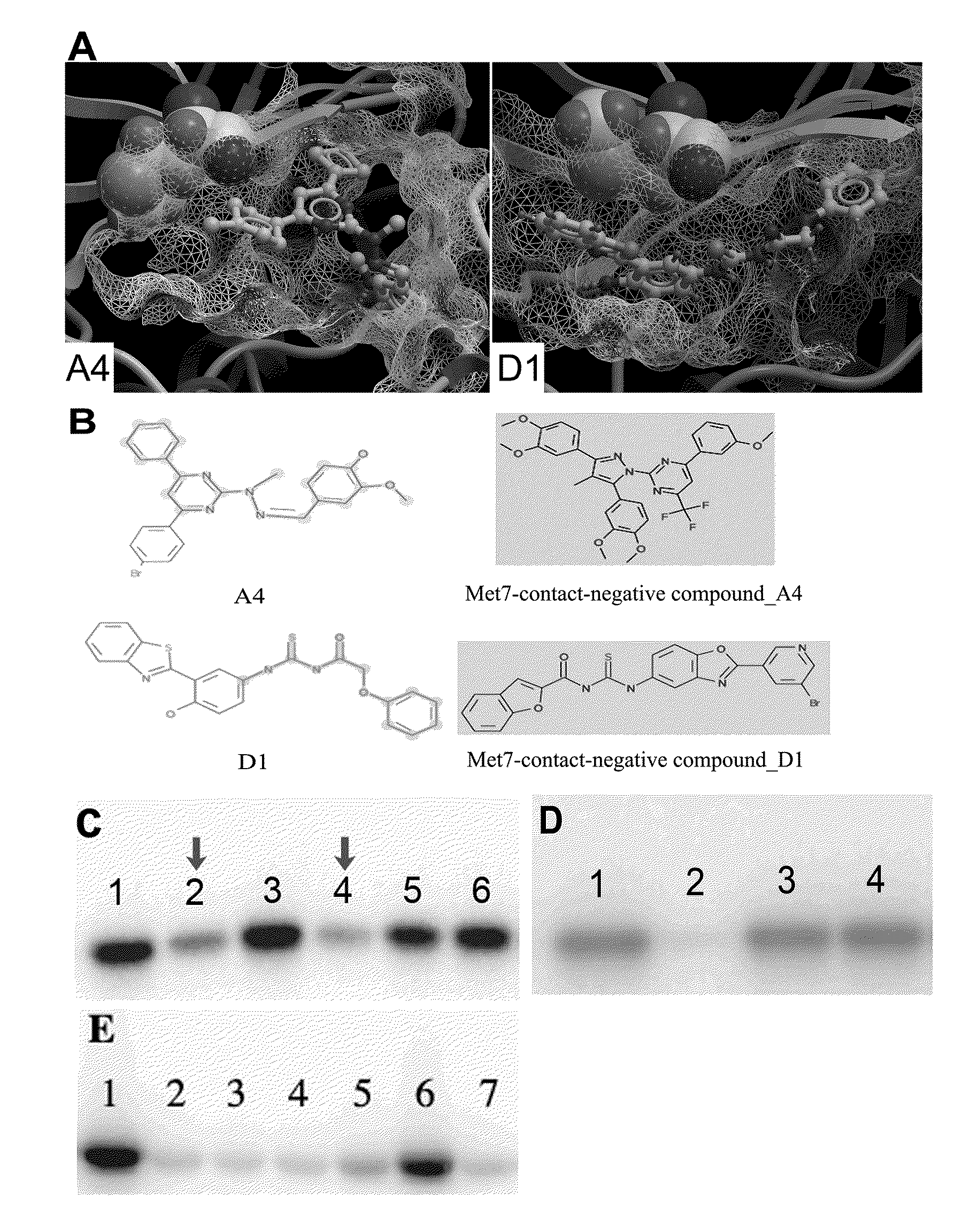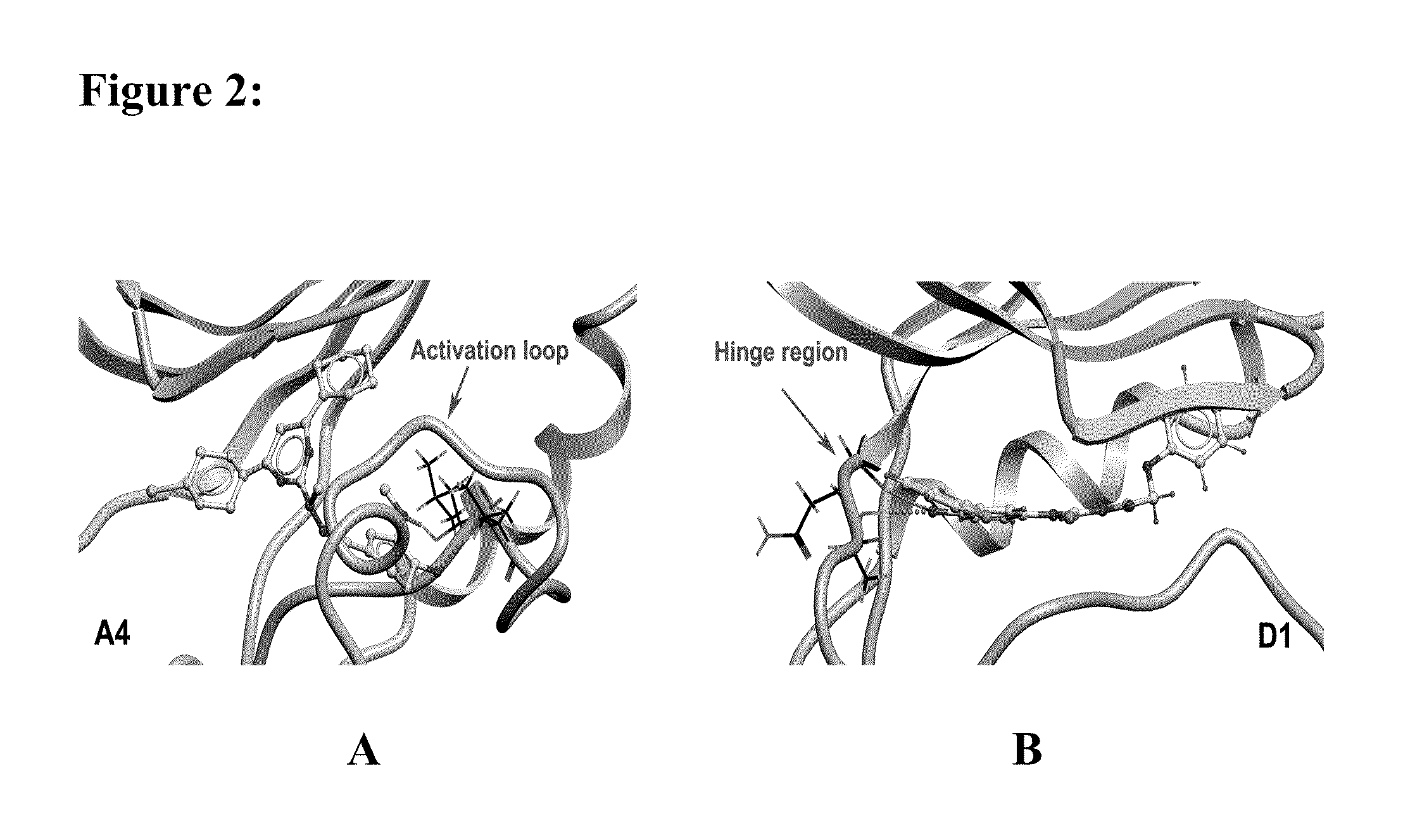Method of treating cancer by inhibition of protein kinase-like endoplasmic reticulum protein kinase
a technology of endoplasmic reticulum and protein kinase, which is applied in the field of cancer treatment by inhibiting protein kinaselike endoplasmic reticulum protein kinase, can solve problems such as stress
- Summary
- Abstract
- Description
- Claims
- Application Information
AI Technical Summary
Benefits of technology
Problems solved by technology
Method used
Image
Examples
example 1
Methods used for Homology Modeling
[0228]In the present invention, the computational work on homology modeling, virtual library screening (VLS) and chemoinformatics was done using ICM software produced by Molsoft, LLC (La Jolla, Calif.) (Abagyan et al., “ICM—A New Method for Protein Modeling and Design: Applications to Docking and Structure Prediction from the Distorted Native Conformation,”J Comp Chem 15:488-506 (1994), which is hereby incorporated by reference in its entirety). Two crystal structures of eIF2α kinase GCN2 (PDB code: 1zy4 & 1zy5) were chosen as the templates for modeling the PERK catalytic domain. The two homology models were initially built using the ICM method (Cardozo et al., “Homology Modeling by the ICM Method,”Proteins 23:403-14 (1995), which is hereby incorporated by reference in its entirety), followed by sampling of the activation loop. This ensemble of multiple receptor conformations was used for subsequent docking experiments. The residues were numbered st...
example 2
Structure-Based Database Search
[0230]ICM-based virtual library screening is based on fast docking of a flexible ligand to a grid representation of the receptor followed by an evaluation of the docked conformation with a scoring function. The ICM scoring function takes into account conformational entropy loss and solvation electrostatic energy change (Cavasotto et al., “Protein Flexibility in Ligand Docking and Virtual Screening to Protein Kinases,”J Mol Biol 337:209-25 (2004), which is hereby incorporated by reference in its entirety), which are critical for accuracy of the scoring function. The ATP binding site in PERK homology models was initially screened against a collection of 315,102 compounds of the ChemBridge Express Library (San Diego, Calif.). Compounds with a docking score less than or equal to -32 were filtered by hydrogen bonds and van der Waals contacts, followed by hierarchical clustering according to chemical similarity. After visual inspection, the selected compound...
example 3
Identification of Structural Determinants of PERK Inhibition from Compounds Tested in vitro
[0231]Residues making contact with the ligand were analyzed for each of the active and inactive compounds. The Wilcoxon rank sum test (Wilcoxon, F. “Individual Comparisons by Ranking Methods,”Biometrics Bulletin 1:80-83 (1945), which is hereby incorporated by reference in its entirety) was performed to identify the difference on van der Waals contact area with certain residues between the two groups.
PUM
| Property | Measurement | Unit |
|---|---|---|
| Fraction | aaaaa | aaaaa |
| Length | aaaaa | aaaaa |
| Force | aaaaa | aaaaa |
Abstract
Description
Claims
Application Information
 Login to View More
Login to View More - R&D
- Intellectual Property
- Life Sciences
- Materials
- Tech Scout
- Unparalleled Data Quality
- Higher Quality Content
- 60% Fewer Hallucinations
Browse by: Latest US Patents, China's latest patents, Technical Efficacy Thesaurus, Application Domain, Technology Topic, Popular Technical Reports.
© 2025 PatSnap. All rights reserved.Legal|Privacy policy|Modern Slavery Act Transparency Statement|Sitemap|About US| Contact US: help@patsnap.com



